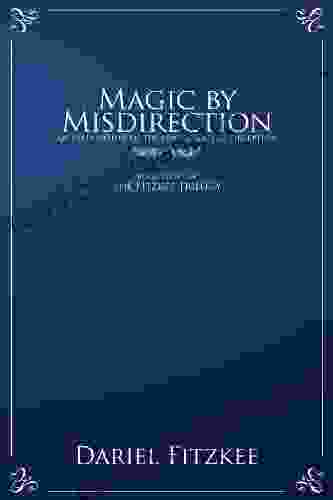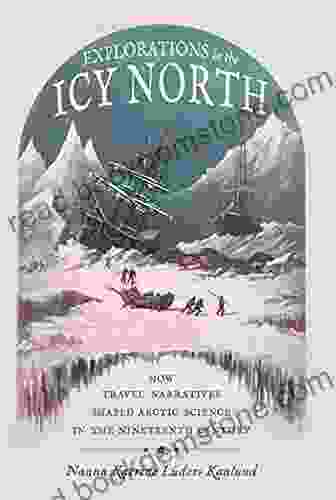Explorations in the Icy North: A Journey into the Arctic and Antarctic Wilderness

The Arctic and Antarctic, often referred to as the "polar regions," are Earth's most extreme environments. Bound by vast oceans and dominated by towering ice sheets, these frozen wildernesses have captivated the imagination of explorers, scientists, and adventurers for centuries.
5 out of 5
| Language | : | English |
| File size | : | 7357 KB |
| Text-to-Speech | : | Enabled |
| Screen Reader | : | Supported |
| Enhanced typesetting | : | Enabled |
| Word Wise | : | Enabled |
| Print length | : | 240 pages |
Driven by a thirst for knowledge, a desire for discovery, and a fascination with the unknown, intrepid explorers have embarked on countless expeditions into these unforgiving landscapes. Their harrowing tales of survival, groundbreaking scientific discoveries, and encounters with unparalleled natural wonders have shaped our understanding of our planet.
Arctic Explorations
Early Expeditions
The Arctic, with its sprawling tundra, massive glaciers, and frozen seas, has long attracted the interest of explorers. In the 16th and 17th centuries, European explorers ventured into the Arctic Circle, seeking new trade routes and the elusive Northwest Passage.
Notable early expeditions included those led by Martin Frobisher, John Davis, and William Baffin, who charted the coastline of Northern Canada and Greenland. These expeditions laid the groundwork for future Arctic exploration and paved the way for scientific research.
19th Century Discoveries
The 19th century marked a period of intense exploration in the Arctic. British explorer Sir John Franklin led several ill-fated expeditions in search of the Northwest Passage, ultimately perishing in the frozen wilderness. However, his tragic expeditions provided valuable scientific data and contributed to our understanding of Arctic conditions.
Other notable 19th century expeditions included those by Elisha Kent Kane, Isaac Israel Hayes, and Frederick Albert Cook, who explored the Arctic by ship and sled. Their discoveries expanded our knowledge of Arctic geography and paved the way for future scientific expeditions.
20th Century Exploration and Research
The 20th century saw a surge in Arctic exploration, fueled by advances in technology and scientific curiosity. Expeditions such as the Amundsen-Scott Expedition (1911-1912),led by Roald Amundsen, achieved milestones in polar exploration, reaching the South Pole for the first time.
Throughout the 20th century, scientific research in the Arctic intensified. Scientists studied the region's climate, geology, wildlife, and the effects of human activity. These studies provided critical data for understanding the Arctic ecosystem and its changing environment.
Antarctic Explorations
Early Expeditions
While the Arctic has a rich history of exploration, the Antarctic remained largely unexplored until the 19th century. In 1819, Russian explorer Fabian Gottlieb von Bellingshausen led an expedition that sighted the Antarctic continent for the first time.
In 1820, American sealer Nathaniel Palmer also sighted the Antarctic Peninsula, further fueling interest in the region. Subsequent expeditions by James Cook, James Clark Ross, and Dumont D'Urville further explored the coastline and mapped the interior.
Heroic Era of Exploration
The early 20th century marked the "Heroic Era of Antarctic Exploration," when numerous expeditions raced to reach the South Pole. Notable figures of this era include Robert Falcon Scott, Ernest Shackleton, and Roald Amundsen.
Amundsen's expedition achieved the historic feat of reaching the South Pole first in 1911. Scott's expedition reached the South Pole a month later, but tragically perished on their return journey.
Scientific Research and Conservation
Following the Heroic Era, scientific research in the Antarctic intensified. Scientists began studying the region's unique wildlife, geology, and climate. In 1959, the Antarctic Treaty was signed, establishing Antarctica as a scientific preserve and fostering international collaboration.
Today, research stations from various countries are located throughout the Antarctic, conducting studies on everything from climate change to penguin behavior. Conservation efforts are also underway to protect the fragile Antarctic ecosystem from human impact.
Challenges and Triumphs of Polar Exploration
Polar exploration has always been fraught with challenges and risks. Explorers have faced extreme cold, treacherous ice, violent storms, and months of isolation. Many have lost their lives in the pursuit of discovery.
Despite the risks, polar exploration has also yielded remarkable triumphs. Explorers have discovered new lands, expanded our knowledge of the Earth's geography, and deepened our understanding of the natural world.
The scientific discoveries made through polar exploration have contributed to our understanding of climate change, biodiversity, and the importance of conservation. These regions are also reminders of the fragility of our planet and the need to protect these pristine wildernesses.
Explorations in the icy north have been a testament to the human spirit of adventure, curiosity, and resilience. From the early expeditions seeking new trade routes to the scientific research stations of today, polar exploration has shaped our understanding of the Earth and our place in it.
As we continue to grapple with the challenges of climate change and environmental degradation, the Arctic and Antarctic remain vital areas of study and conservation. By exploring these icy realms, we not only unravel the secrets of our planet's past but also ensure the health of our future.
5 out of 5
| Language | : | English |
| File size | : | 7357 KB |
| Text-to-Speech | : | Enabled |
| Screen Reader | : | Supported |
| Enhanced typesetting | : | Enabled |
| Word Wise | : | Enabled |
| Print length | : | 240 pages |
Do you want to contribute by writing guest posts on this blog?
Please contact us and send us a resume of previous articles that you have written.
 Best Book
Best Book Page Flip
Page Flip Bookshelf
Bookshelf Literary loom
Literary loom Chapter
Chapter Bookish
Bookish PageTurner
PageTurner Bibliophile
Bibliophile Story
Story Inkwell
Inkwell Bookworm
Bookworm Labyrinth
Labyrinth Plot Twist
Plot Twist Prose
Prose Paperback
Paperback Storyteller
Storyteller Sanctuary
Sanctuary Fiction
Fiction Reading
Reading Chronicle
Chronicle Read
Read Roberta Milliken
Roberta Milliken Alberta Arthurs
Alberta Arthurs Andrew Forkner
Andrew Forkner Charles Bowden
Charles Bowden J C Cannell
J C Cannell Kelly Mills
Kelly Mills A S Byatt
A S Byatt Dean Simmons
Dean Simmons Laura Shumaker
Laura Shumaker Andrew Crone
Andrew Crone Tyrel Nelson
Tyrel Nelson David Garner
David Garner James Egan
James Egan Sean Michael Andrews
Sean Michael Andrews Darren Royston
Darren Royston Michael F Keaney
Michael F Keaney Sam Tranum
Sam Tranum Henry White
Henry White Gregory Mirow
Gregory Mirow E Train Learning
E Train Learning Sean Willson
Sean Willson Gautam Raghavan
Gautam Raghavan Renato Perdon
Renato Perdon Rowland B Wilson
Rowland B Wilson Dean C Moore
Dean C Moore David Elliot Cohen
David Elliot Cohen Christopher James
Christopher James Lisa Maker
Lisa Maker Tarana Burke
Tarana Burke Maxim D Shrayer
Maxim D Shrayer William Bennet Stevenson
William Bennet Stevenson Olympia Black
Olympia Black Shannon Pemrick
Shannon Pemrick Peter Watts
Peter Watts Aaron Barron
Aaron Barron Jeremy Hicks
Jeremy Hicks A J Finn
A J Finn Maureen Egan
Maureen Egan Jan Gaye
Jan Gaye Catherine Grace Katz
Catherine Grace Katz A R Corbin
A R Corbin Jeffrey Eugenides
Jeffrey Eugenides Dean Wesley Smith
Dean Wesley Smith David Cousens
David Cousens David Newton
David Newton Laura J Mixon
Laura J Mixon Nick Jones
Nick Jones Sara Novic
Sara Novic Shira Lipkin
Shira Lipkin Erwin Rosenthal
Erwin Rosenthal Julie Metz
Julie Metz Erin Khar
Erin Khar Tony Barr
Tony Barr Dannion Brinkley
Dannion Brinkley Ray Loriga
Ray Loriga J D Sullivan
J D Sullivan Carl Little
Carl Little Debra Meyerson
Debra Meyerson Ruth Millington
Ruth Millington David Blacklock
David Blacklock Editors Of Creative Publishing International
Editors Of Creative Publishing International Paolo Hewitt
Paolo Hewitt A F Kay
A F Kay Emily Gosling
Emily Gosling Catie Marron
Catie Marron Jack Womack
Jack Womack Brittany Gibbons
Brittany Gibbons Tommaso Astarita
Tommaso Astarita Sheila Weller
Sheila Weller Leonard Peltier
Leonard Peltier Thomas Lockwood
Thomas Lockwood Tao Wong
Tao Wong Marlon James
Marlon James Lewis Hyde
Lewis Hyde Arnold Lowrey
Arnold Lowrey David Nabhan
David Nabhan Margo Bond Collins
Margo Bond Collins Janice Dean Willis
Janice Dean Willis Kate Clair
Kate Clair Belle Yang
Belle Yang Stephen Powell
Stephen Powell Nigel Cross
Nigel Cross Rebecca Vincent
Rebecca Vincent Bill Gardner
Bill Gardner Trevor Norton
Trevor Norton Bob Chapman
Bob Chapman Mazie K Hirono
Mazie K Hirono Negar Mottahedeh
Negar Mottahedeh Catherine Kapphahn
Catherine Kapphahn Colin Post
Colin Post Aaron Bobrow Strain
Aaron Bobrow Strain Mark Dery
Mark Dery Lindsay Buroker
Lindsay Buroker K Kris Loomis
K Kris Loomis Victor Steffensen
Victor Steffensen Sabra Waldfogel
Sabra Waldfogel Christopher Ruocchio
Christopher Ruocchio Shirlene Obuobi
Shirlene Obuobi Casey Gerald
Casey Gerald Fred Crellin
Fred Crellin Rebecca Dwight Bruff
Rebecca Dwight Bruff Andy Clark
Andy Clark Ted Riese
Ted Riese Robert Shufflebotham
Robert Shufflebotham Mo Yan
Mo Yan W David Baird
W David Baird C J Cherryh
C J Cherryh Chris Backe
Chris Backe Jonathan Harr
Jonathan Harr Soraya French
Soraya French Douglas E Richards
Douglas E Richards David Gentleman
David Gentleman Kaylie Kay
Kaylie Kay Daniel Jacobs
Daniel Jacobs A K Duboff
A K Duboff Stephanie Thornton
Stephanie Thornton Juliet Rieden
Juliet Rieden Mari Sandoz
Mari Sandoz Bernardine Evaristo
Bernardine Evaristo Trevor Boffone
Trevor Boffone Barbara Barrett
Barbara Barrett Edward Leo
Edward Leo Marina Berkovich
Marina Berkovich Elena Ferro
Elena Ferro Peter A Koenig
Peter A Koenig M P Woodward
M P Woodward Sam J Miller
Sam J Miller Aimee Song
Aimee Song Sylvia D Lynch
Sylvia D Lynch A J Alonzo Wind
A J Alonzo Wind David Hinton
David Hinton Don Croner
Don Croner Richard Wagamese
Richard Wagamese Jennifer Natalya Fink
Jennifer Natalya Fink Leesa Cross Smith
Leesa Cross Smith Michael A Almond
Michael A Almond Shemer Kuznits
Shemer Kuznits Bernie Schein
Bernie Schein Terence Biffi
Terence Biffi Simon Scarrow
Simon Scarrow A D Davies
A D Davies James Just
James Just John Hopkins
John Hopkins Cazzie David
Cazzie David 2nd Edition Kindle Edition
2nd Edition Kindle Edition Blake Gopnik
Blake Gopnik Graham Fraser
Graham Fraser Peter Swanson
Peter Swanson Jane M Newby
Jane M Newby Charles Johnson
Charles Johnson Chris Hechtl
Chris Hechtl Danielle Ofri
Danielle Ofri Alexander William Kinglake
Alexander William Kinglake Jesse Day
Jesse Day Peter Rush
Peter Rush Darra Goldstein
Darra Goldstein Elizabeth Currie
Elizabeth Currie Ramze Suliman
Ramze Suliman Beate Sirota Gordon
Beate Sirota Gordon Jules Gailhabaud
Jules Gailhabaud Michael Wigge
Michael Wigge Robyn Wideman
Robyn Wideman Dave Austin
Dave Austin Natasha Lawyer
Natasha Lawyer Tracey Cohen
Tracey Cohen Joseph Farrell
Joseph Farrell Mary Jane Walker
Mary Jane Walker Ken Liu
Ken Liu Bob Sehlinger
Bob Sehlinger Jack Hunt
Jack Hunt Jo Charnock
Jo Charnock Maud Fontenoy
Maud Fontenoy Jhumpa Lahiri
Jhumpa Lahiri A C Arthur
A C Arthur James Willard Schultz
James Willard Schultz Winki
Winki Lisa Jackson
Lisa Jackson Gary Orleck
Gary Orleck Jit Baral
Jit Baral Brad Warner
Brad Warner Cynthia Sax
Cynthia Sax Mary Gabriel
Mary Gabriel Anne Strathie
Anne Strathie Shana Vanterpool
Shana Vanterpool Luis Tiant
Luis Tiant Dean Dalton
Dean Dalton Heinrich Klutschak
Heinrich Klutschak Alex W White
Alex W White Bridget Quinn
Bridget Quinn Toby Neighbors
Toby Neighbors Terrance Mulloy
Terrance Mulloy Javier Zamora
Javier Zamora Lynn Michelsohn
Lynn Michelsohn Daniel Sheets Dye
Daniel Sheets Dye Ethan De Seife
Ethan De Seife Ranim Nourallah
Ranim Nourallah David Bergsland
David Bergsland Neil Hutchison
Neil Hutchison Brandon Ellis
Brandon Ellis Charles Foran
Charles Foran Karin Tanabe
Karin Tanabe Sarah Bird
Sarah Bird Pete Buckley
Pete Buckley Phyllis Birnbaum
Phyllis Birnbaum Heather Webb
Heather Webb Diana K Schwam
Diana K Schwam Jenny Mcgill
Jenny Mcgill Barbara Newton
Barbara Newton Noah Scalin
Noah Scalin Joanna Kulesza
Joanna Kulesza John Marmysz
John Marmysz Mamie Till Mobley
Mamie Till Mobley Gary Heath
Gary Heath Suyi Davies Okungbowa
Suyi Davies Okungbowa Jennifer Rosner
Jennifer Rosner Scotia Gilroy
Scotia Gilroy A P Bateman
A P Bateman Aaron Dembski Bowden
Aaron Dembski Bowden Meyer Levin
Meyer Levin Andres Lopez
Andres Lopez R H Sin
R H Sin Michelle Knight
Michelle Knight Cynthia Knox
Cynthia Knox Bruce Scivally
Bruce Scivally Glennon Doyle
Glennon Doyle Larry Niven
Larry Niven Brant Antonson
Brant Antonson Stanley Green
Stanley Green 3dtotal Publishing
3dtotal Publishing Megan Mackie
Megan Mackie Shaa Fazal
Shaa Fazal Zen Cho
Zen Cho Rich Horton
Rich Horton Margo Porras
Margo Porras Dk
Dk Partha Mitter
Partha Mitter Dani Cavallaro
Dani Cavallaro Salvador Dali
Salvador Dali Melissa Fu
Melissa Fu Charles Alexander Eastman
Charles Alexander Eastman Phylis Johnson
Phylis Johnson Clive Cussler
Clive Cussler Benedict Jacka
Benedict Jacka Tony Corden
Tony Corden Natasha Sims
Natasha Sims Jen Santos
Jen Santos Gregory Crouch
Gregory Crouch Soon Y Warren
Soon Y Warren Paul C Middleton
Paul C Middleton Sambou Kamissoko
Sambou Kamissoko Jihyun Park
Jihyun Park A C Crispin
A C Crispin Joel Paul Reisig
Joel Paul Reisig Cecelia Dowdy
Cecelia Dowdy Jon Tucker
Jon Tucker Paul Austin Ardoin
Paul Austin Ardoin Kathy Arlyn Sokol
Kathy Arlyn Sokol Paul R Wonning
Paul R Wonning Birnbaum Guides
Birnbaum Guides Dave Willmarth
Dave Willmarth Ava Ross
Ava Ross Mel Laytner
Mel Laytner Richard Taylor
Richard Taylor Rhys Bowen
Rhys Bowen Christopher Ingraham
Christopher Ingraham V S Naipaul
V S Naipaul S L Partee
S L Partee Brandi Carlile
Brandi Carlile Yanis Varoufakis
Yanis Varoufakis David Lewis
David Lewis Stephen Farthing
Stephen Farthing Koichi Hagawa
Koichi Hagawa Robert S Birchard
Robert S Birchard Audre Lorde
Audre Lorde 1st Ed 2018 Edition Kindle Edition
1st Ed 2018 Edition Kindle Edition Rosalind Rosenberg
Rosalind Rosenberg Patricia Bjaaland Welch
Patricia Bjaaland Welch Larry Moss
Larry Moss Agathe Singer
Agathe Singer Maria Sibylla Merian
Maria Sibylla Merian Cixin Liu
Cixin Liu Ann V Winterbotham
Ann V Winterbotham Diego Enrique Osorno
Diego Enrique Osorno Raymond Goodburn
Raymond Goodburn Alex Stone
Alex Stone Seth Ring
Seth Ring Zoe Ingram
Zoe Ingram Tenzin Priyadarshi
Tenzin Priyadarshi Dale Brown
Dale Brown Joshua Bloom
Joshua Bloom John D Gartner
John D Gartner Alison Bechdel
Alison Bechdel Roxie Mcclaine
Roxie Mcclaine Michael C Grumley
Michael C Grumley Susan Veness
Susan Veness Leo Kahl
Leo Kahl Kate Langbroek
Kate Langbroek Goddess Love
Goddess Love Richard F Fleck
Richard F Fleck Actus
Actus Tony Spawforth
Tony Spawforth Michael Brooke
Michael Brooke Lawrence F Lihosit
Lawrence F Lihosit Maisy Card
Maisy Card Luther Standing Bear
Luther Standing Bear Leslie Cabarga
Leslie Cabarga David Feintuch
David Feintuch Joseph Q Jarvis
Joseph Q Jarvis Noah Brooks
Noah Brooks Richard Condit
Richard Condit Guidora Team
Guidora Team Greydon Clark
Greydon Clark Laurence Matthews
Laurence Matthews Laura Lee Fritz
Laura Lee Fritz Kate Sekules
Kate Sekules Julian Barnes
Julian Barnes Michael Petrou
Michael Petrou Reginald Fleming Johnston
Reginald Fleming Johnston Todd Mcgowan
Todd Mcgowan Doug Risner
Doug Risner Cyrus Massoudi
Cyrus Massoudi Thais Riotto
Thais Riotto Steve Gladstone
Steve Gladstone J T Brannan
J T Brannan Lakia
Lakia Aisling Juanjuan Shen
Aisling Juanjuan Shen Nikki Giovanni
Nikki Giovanni Ina Knobloch
Ina Knobloch Dmitry Samarov
Dmitry Samarov Donald B Mcfarlane
Donald B Mcfarlane Heather Young
Heather Young Nicole Koetter
Nicole Koetter David Parker
David Parker Insight Traveller
Insight Traveller Donna Digiuseppe
Donna Digiuseppe Michael Crichton
Michael Crichton Gustavo Arellano
Gustavo Arellano Donald Bogle
Donald Bogle Tricia Martineau Wagner
Tricia Martineau Wagner Ralph Ellison
Ralph Ellison Laura L Engel
Laura L Engel J M Phillips
J M Phillips Daniel Mathews
Daniel Mathews Shantiana Cooper
Shantiana Cooper C Napier Bell
C Napier Bell Kate Clifford Larson
Kate Clifford Larson William F Powell
William F Powell Vicky Unwin
Vicky Unwin Andy Fletcher
Andy Fletcher Brian Morton
Brian Morton Walter Crane
Walter Crane Christopher Fowler
Christopher Fowler K Reynolds James
K Reynolds James Susan R Barry
Susan R Barry Ann Fensterstock
Ann Fensterstock Stephen Chambers
Stephen Chambers Bruce Carroll
Bruce Carroll Octavia E Butler
Octavia E Butler Paul Daugherty
Paul Daugherty Tonya Burrows
Tonya Burrows Nawar Shora
Nawar Shora Roman Plesky
Roman Plesky Mark Harris
Mark Harris Dawn Loring
Dawn Loring Andre Iguodala
Andre Iguodala Michelle Vogel
Michelle Vogel Henri Piquer
Henri Piquer Diana Marcum
Diana Marcum Shelly Culbertson
Shelly Culbertson James Osiris Baldwin
James Osiris Baldwin Lina Chang
Lina Chang Garry Apgar
Garry Apgar Susie Kalil
Susie Kalil Alta Macadam
Alta Macadam Collins Uk
Collins Uk Edmund De Waal
Edmund De Waal Julia Whelan
Julia Whelan Reed Tucker
Reed Tucker Jung Yun
Jung Yun Jennifer Melville
Jennifer Melville S E Smith
S E Smith Gerald Shea
Gerald Shea Karen Speerstra
Karen Speerstra Sarah Torrecillas
Sarah Torrecillas Gary Phillips
Gary Phillips R Allen Hardy
R Allen Hardy Julia Elizabeth Sloan
Julia Elizabeth Sloan Shannon Leone Fowler
Shannon Leone Fowler Leatrice Eiseman
Leatrice Eiseman Pierre Alex Jeanty
Pierre Alex Jeanty Eduardo F Calcines
Eduardo F Calcines Burt Wrenlaw
Burt Wrenlaw A Sanguineti
A Sanguineti Paraluman S Aspillera
Paraluman S Aspillera Joseph D Addetta
Joseph D Addetta Stephen Baxter
Stephen Baxter Ann Patchett
Ann Patchett Sarah Noffke
Sarah Noffke Kresley Cole
Kresley Cole David Sipress
David Sipress John Edson
John Edson Bwwm Club
Bwwm Club Linda Kinstler
Linda Kinstler Paul Hill
Paul Hill Alyssa Cole
Alyssa Cole Mark Jones
Mark Jones Douglas Dorow
Douglas Dorow Bob Kaufman
Bob Kaufman Alison C Board
Alison C Board Gay Talese
Gay Talese Isabella Decarlo
Isabella Decarlo Alastair Campbell
Alastair Campbell Deby Coles
Deby Coles Bill Robinson
Bill Robinson Mary Kubica
Mary Kubica Jeffrey Wilson
Jeffrey Wilson Dwight Roth
Dwight Roth Yvonne Wakefield
Yvonne Wakefield Amarilys Henderson
Amarilys Henderson Victor Godinez
Victor Godinez Alexandre Roger
Alexandre Roger Carol Boyle
Carol Boyle Chris Robinson
Chris Robinson A A Villescas
A A Villescas Jenell Diegor
Jenell Diegor William Middleton
William Middleton Scott Peters
Scott Peters Mark Greaney
Mark Greaney Judy O Haselhoef
Judy O Haselhoef Ann Fisher
Ann Fisher Joseph M Mascia
Joseph M Mascia Chris Bond
Chris Bond Joanna Merlin
Joanna Merlin Sharon Shinn
Sharon Shinn David Hornung
David Hornung Nanna Katrine Luders Kaalund
Nanna Katrine Luders Kaalund Martha Wainwright
Martha Wainwright Morgan Jerkins
Morgan Jerkins Kamo
Kamo Victoria Buitron
Victoria Buitron Carlos Simpson
Carlos Simpson Charissa N Terranova
Charissa N Terranova Yihui Xie
Yihui Xie Porsha Williams
Porsha Williams Christopher L Cirillo
Christopher L Cirillo Sylvester Murray
Sylvester Murray Michael Gross
Michael Gross Ernest R Norling
Ernest R Norling Shawna Sharee
Shawna Sharee Natasha Brown
Natasha Brown Tania Romanov
Tania Romanov Aileen Bordman
Aileen Bordman Joe Upton
Joe Upton Roger Williams
Roger Williams Robert Fleming
Robert Fleming Aaron Fine
Aaron Fine Aaron James Draplin
Aaron James Draplin Tina Martin
Tina Martin A Michael Shumate
A Michael Shumate Annalyn Swan
Annalyn Swan Derek Hough
Derek Hough T Ann Marie
T Ann Marie Paul Norbury
Paul Norbury Tom Cotter
Tom Cotter A R Burns
A R Burns Madeleine Korbel Albright
Madeleine Korbel Albright Jarrett Wrisley
Jarrett Wrisley Melverna Mcfarlane
Melverna Mcfarlane Martin Fletcher
Martin Fletcher R W W Greene
R W W Greene Harry Turtledove
Harry Turtledove Kitiara Pascoe
Kitiara Pascoe Catherine Belsey
Catherine Belsey Beth Reiber
Beth Reiber Rosemary Edghill
Rosemary Edghill Robert E Kapsis
Robert E Kapsis Lisa Rose Wright
Lisa Rose Wright Elizabeth Strout
Elizabeth Strout Valeria Luiselli
Valeria Luiselli Donald Richie
Donald Richie Tim Lebbon
Tim Lebbon Penelope Douglas
Penelope Douglas Philippe Chantepie
Philippe Chantepie John Gimlette
John Gimlette Weijian Shan
Weijian Shan Jeff A Menges
Jeff A Menges Amanda Conner
Amanda Conner John F Callahan
John F Callahan Bruce Sentar
Bruce Sentar R A Scotti
R A Scotti Ernest Chesneau
Ernest Chesneau C C Alma
C C Alma Elizabeth Kendall
Elizabeth Kendall Harmony Bench
Harmony Bench Jay Boyce
Jay Boyce Tara Bray Smith
Tara Bray Smith Jeaniene Frost
Jeaniene Frost Cora Harrington
Cora Harrington Monica Peach
Monica Peach Sam Hampton Smith
Sam Hampton Smith Carrie Prudence Winter
Carrie Prudence Winter Marina Abramovic
Marina Abramovic Jeffrey Ford
Jeffrey Ford Marie Arana
Marie Arana Mosy Brigth
Mosy Brigth James Abell
James Abell Robin Barratt
Robin Barratt Rocky Nielsen
Rocky Nielsen Ron Mcninch
Ron Mcninch S M Warlow
S M Warlow Stephen Haddelsey
Stephen Haddelsey Juno Wells
Juno Wells Selena Montgomery
Selena Montgomery James Robert
James Robert Shellise Berry
Shellise Berry Samantha Seiple
Samantha Seiple John Christian Hopkins
John Christian Hopkins A American
A American Michael Roberts
Michael Roberts M N Forgy
M N Forgy Eddie Lennon
Eddie Lennon Calvin Tomkins
Calvin Tomkins Troy Denning
Troy Denning Anne Wheeler
Anne Wheeler Marjorie Lambert
Marjorie Lambert Kira Salak
Kira Salak Theophilus Monroe
Theophilus Monroe Rachel Woods
Rachel Woods Jessica Augustsson
Jessica Augustsson Bryony Gomez Palacio
Bryony Gomez Palacio Greg Sarris
Greg Sarris Jeff Howard
Jeff Howard Brad Thor
Brad Thor A Desaint
A Desaint Charles Barr
Charles Barr Ben Ryan
Ben Ryan Rose Gonnella
Rose Gonnella Giorgia Lupi
Giorgia Lupi Anuj Tikku
Anuj Tikku Belinda Jones
Belinda Jones Neil A Hogan
Neil A Hogan Deborah Hay
Deborah Hay Daniel Van
Daniel Van Ray Balkwill
Ray Balkwill Laurie Gwen Shapiro
Laurie Gwen Shapiro Joshua Samuel Brown
Joshua Samuel Brown Koloman Moser
Koloman Moser J B Bobo
J B Bobo Maggie Black
Maggie Black Gary David Bouton
Gary David Bouton Nek Hickmon
Nek Hickmon Daniel Gordis
Daniel Gordis Jane Alexander
Jane Alexander Kenneth Clark
Kenneth Clark Jane Allen Petrick
Jane Allen Petrick Thom Wall
Thom Wall Christa Upton
Christa Upton Ayano Otani
Ayano Otani Lisa Ohlen Harris
Lisa Ohlen Harris David Batchelor
David Batchelor Gary O Neal
Gary O Neal Jill Santopolo
Jill Santopolo Dale Sherman
Dale Sherman Brian J Robb
Brian J Robb Justin Catanoso
Justin Catanoso Henry Dreyfuss
Henry Dreyfuss James M Mcpherson
James M Mcpherson Fernanda Melchor
Fernanda Melchor Helen Raleigh
Helen Raleigh Merick N H Ulrik
Merick N H Ulrik Joan Wiener Bordow
Joan Wiener Bordow Mark J Rose
Mark J Rose Nathan Brown
Nathan Brown Bill Neeley
Bill Neeley Trice Hickman
Trice Hickman Linea Johnson
Linea Johnson Walter Jon Williams
Walter Jon Williams Danny Garcia
Danny Garcia Gail Lukasik
Gail Lukasik Christine Skwiot
Christine Skwiot 1st Edition Kindle Edition
1st Edition Kindle Edition A M Sohma
A M Sohma Brette Sember
Brette Sember Tom Sullivan
Tom Sullivan Alex Kosh
Alex Kosh Jennifer Bohnet
Jennifer Bohnet Mary Jane Houlton
Mary Jane Houlton Clint Salter
Clint Salter Carma Gorman
Carma Gorman Victor Margolin
Victor Margolin Mary Prince
Mary Prince Dustin Stevens
Dustin Stevens Aaris Sherin
Aaris Sherin Peter Cozzens
Peter Cozzens Kathleen Jones
Kathleen Jones Sarah Fraser
Sarah Fraser Adam Bray
Adam Bray Tori Harris
Tori Harris Daniel Tudor
Daniel Tudor Shvonne Latrice
Shvonne Latrice Hilary Hughes Loftus
Hilary Hughes Loftus Aabis Johnson
Aabis Johnson Richard Kaufman
Richard Kaufman Jeffrey Alford
Jeffrey Alford Megan Goldmine
Megan Goldmine Gary Earl Ross
Gary Earl Ross Nick Iuppa
Nick Iuppa Charles Harrison
Charles Harrison Michael Bierut
Michael Bierut John Cheever
John Cheever Matthew Poehler
Matthew Poehler Maryanne Peters
Maryanne Peters William O Connor
William O Connor Janice Cavell
Janice Cavell Etienne De Backer
Etienne De Backer Elsebeth Lavold
Elsebeth Lavold Marina Jarre
Marina Jarre Fred Arroyo
Fred Arroyo Karen Haid
Karen Haid Scott Lunt
Scott Lunt Brandon Sanderson
Brandon Sanderson Nick Athanas
Nick Athanas Stan Zimmerman
Stan Zimmerman Dami Lee
Dami Lee Steve Kaffen
Steve Kaffen 1st Ed 2019 Edition Kindle Edition
1st Ed 2019 Edition Kindle Edition John E Siers
John E Siers Delia Gray Durant
Delia Gray Durant
Light bulbAdvertise smarter! Our strategic ad space ensures maximum exposure. Reserve your spot today!

 Dennis HayesThe Treasury of Traditional Stained Glass Designs: A Masterpiece for Glass...
Dennis HayesThe Treasury of Traditional Stained Glass Designs: A Masterpiece for Glass...
 Abe MitchellMagic by Misdirection: The Fitzkee Trilogy - A Journey Through Deception and...
Abe MitchellMagic by Misdirection: The Fitzkee Trilogy - A Journey Through Deception and...
 Alexander BlairThe Jewelry Engravers Manual: A Comprehensive Guide to Jewelry Engraving...
Alexander BlairThe Jewelry Engravers Manual: A Comprehensive Guide to Jewelry Engraving... D'Angelo CarterFollow ·17k
D'Angelo CarterFollow ·17k Brody PowellFollow ·14.9k
Brody PowellFollow ·14.9k Herb SimmonsFollow ·7.1k
Herb SimmonsFollow ·7.1k Jace MitchellFollow ·11.1k
Jace MitchellFollow ·11.1k Jacob HayesFollow ·5.1k
Jacob HayesFollow ·5.1k Yukio MishimaFollow ·9.3k
Yukio MishimaFollow ·9.3k Shawn ReedFollow ·18.1k
Shawn ReedFollow ·18.1k John ParkerFollow ·12.5k
John ParkerFollow ·12.5k

 Lucas Reed
Lucas ReedFantasy Technology and Politics: A Deep Dive into the...
Fantasy literature...

 Blake Kennedy
Blake KennedyCome To This Court And Cry: A Tale of Love, Loss, and...
Come To This Court And Cry...

 Kendall Ward
Kendall WardThe Majestic Edifice: Exploring the History and...
St. Peter's Basilica, an architectural...

 Emmett Mitchell
Emmett MitchellDraplin Design Co.: Pretty Much Everything
Who is Draplin Design Co.? Draplin Design...

 Eliot Foster
Eliot FosterUnveiling the Enthralling Literary Cosmos of Against Time...
Prologue: A Quantum Nexus of Time and...

 Connor Mitchell
Connor MitchellMy Journey Through the Labyrinth of Low-Budget...
In the enthralling realm of filmmaking,...
5 out of 5
| Language | : | English |
| File size | : | 7357 KB |
| Text-to-Speech | : | Enabled |
| Screen Reader | : | Supported |
| Enhanced typesetting | : | Enabled |
| Word Wise | : | Enabled |
| Print length | : | 240 pages |






